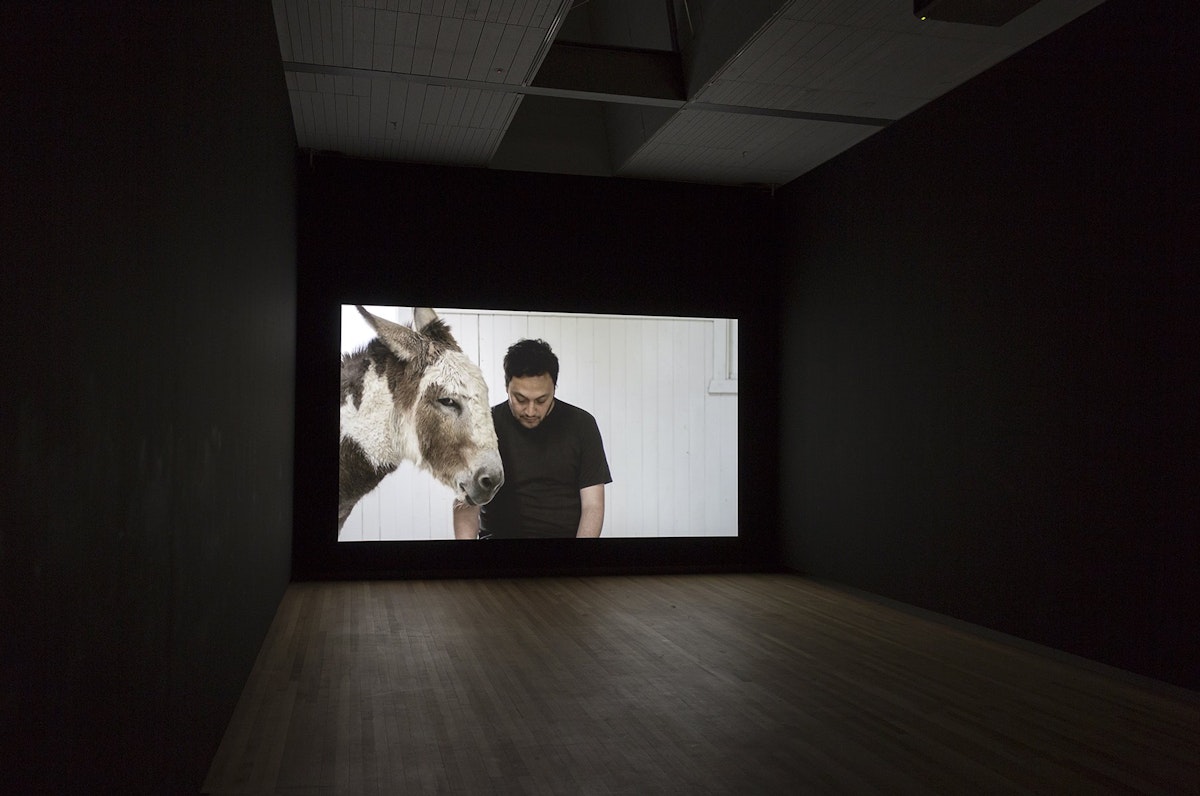The donkey’s name is Chester.(1) His head and eyes are inexplicably forlorn. He blinks, long lashes. Shannon Te Ao stands beside Chester. They are almost the same height. Te Ao is dressed in a black T-shirt, his face tilted downwards, he reads; “…strong is the urge within you to arise and go forth…” Chester sweeps his muzzle over Te Ao’s shoulder.
“…and enter unannounced the abode of indifference.”
Chester faces the wall, his back to the camera.
In the darkened gallery the young couple seated next to me laughed.
I felt like crying.
two shoots that stretch far out was first presented at the 19th Sydney Biennale and is currently on show at City Gallery beside a suite of fantastical drawings by Susan Te Kahurangi King.(2) This nimble, non-literal pairing asks viewers to contemplate communication and non-communication in both artists work. King has not spoken since she was a child; meanwhile Te Ao’s video falls on deaf ears. He reads to animals. His title references a Māori proverb about two gourds facing in opposite directions, “as an analogy about relationships that are inherently flawed.”(3) It also describes the curatorial juxtaposition of these two artists who share just as many differences as similarities.
Te Ao’s video is far out. His combination of ingredients is at once simple and strange: a swan, a wallaby, rabbits, geese, chickens, Chester. (And I don’t use the word ingredients entirely lightly: as a meat eater I felt haunted by this work.) The animals are filmed in the barn that is also their training ground. Te Ao recites a waiata to this unlikely group of thespians. A Song of Two Wives is a lament written by a Ngati Porou woman in response to her husband taking a second wife. Translated into English, the waiata provides the beautiful framework for this video.
“For I heeded your every wish like your canoe by the river…”
The camera pans slowly across the barn evoking the flow of the river. The swan sits on the floorboards, long neck tucked into its body. Te Ao’s voice is a channel for the past, a shoot stretching far out. In each sequence a different animal – or group of animals - occupies the frame. The colours are sparse. In one sequence rabbits jump in and out of view. Their muted brown fur accentuates the bleakness of the barn, its ageing floorboards. Te Ao appears in glimpses. His bare feet. His black jeans. He repeats the lament yet his reading is not a personal address.
Instead the voice from A Song of Two Wives carries, the lonely consciousness of a woman outcast from society – from the animal forces of love and sex - into something less familial and familiar. She describes, “the wretchedness of a husband shared”; at times she speaks directly to her husband, “you have utterly forsaken me.” The formal register of her language lends the video its stately quality. The animals become symbols of her estrangement; “…within my thoughts are vainly thrusting outwards, spread out now is my view of the hill.” The animals seem part of this “view of the hill,” an extension of the natural world evoked in the waiata, yet they also resist being pinned to metaphor.
A wallaby hops around the empty barn. Te Ao follows, walking above it, the hunched little wallaby between his legs. If this all sounds a bit silly, I can assure you it isn’t. But how? The swan is an obviously romantic figure in Western culture but a wallaby? Chickens? Geese? The vulnerability of the animals pervades this work, our potential to harm them. Their proximity to Te Ao – or his to them – is tender and shocking. If I was a vegetarian perhaps my conscience would be clearer? Yet the chosen animals don’t neatly fit a work about the politics of consumption (I’ve never seen donkey on the menu).
Te Ao has said, “the waiata I’m drawn to refer to different aspects of domestic space and tension.”(4)
Sure, but this work has just as much to say about animal husbandry as a marriage in trouble. He’s referred to the animals in the video as “actors or performers in their own right” and they are filmed in the barn that is their rehearsal space.(5) Te Ao’s performative actions also connect to his Māori background: in some Māori tribes animals are believed to be guardian spirits left behind by deceased ancestors. Perhaps that’s why I keep returning to John Berger’s wonderful essay Why Look at Animals? Berger traces our relationship from cave paintings where, “animals first entered the imagination as messengers and promises…” to the evolution of the zoo where animals assume “…an otherwise exclusively human emotion: indifference.”(6)
Yes. The final sequence in Te Ao’s video is also the most affecting. It’s where the two shoots of this work come together. In A Midsummer Night’s Dream, Puck transforms Nick Bottom’s head into that of a donkey’s. The ass is aligned with the fool. This resonates with the rejected voice of the wife in the waiata who is “beguiled by a phantom lover.” But Chester is nobody’s fool. Instead, he appears to return – then reject - the gaze of the viewer. He has entered the abode of indifference.
“That look between animal and man, which must have played a crucial role in the development of human society, and with which in any case, all men had always lived until a century ago, has been extinguished.”(7)
